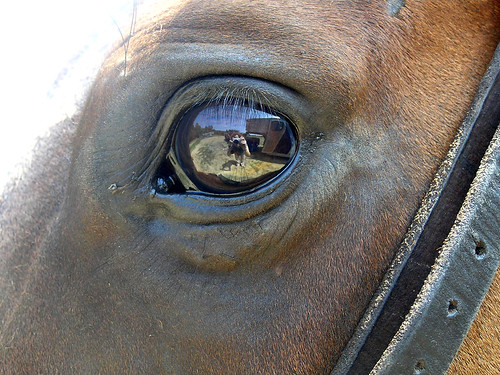 EYES: a horse's pupils cannot widen, so eyes are a bit difficult to read. Usually, a horse has a soft expression around its eye. The area above the eye will show whether the horse is worried or angry. Some horse's, when startled, will show the white area surrounding the eye.
EYES: a horse's pupils cannot widen, so eyes are a bit difficult to read. Usually, a horse has a soft expression around its eye. The area above the eye will show whether the horse is worried or angry. Some horse's, when startled, will show the white area surrounding the eye. MOUTH AND LIPS: A horse's mouth is very expressive. A droopy lower lip on an older horse often denotes a relaxed, content horse, and a horse that chews or licks without food present is being submissive. A nuzzling lip shows affection, while a horse gnashing, grinding, or baring his teeth is showing anger or irritation.
MOUTH AND LIPS: A horse's mouth is very expressive. A droopy lower lip on an older horse often denotes a relaxed, content horse, and a horse that chews or licks without food present is being submissive. A nuzzling lip shows affection, while a horse gnashing, grinding, or baring his teeth is showing anger or irritation.LEGS AND FEETS: A horse that is pawing the ground with a front foot is showing impatience. When it rests one hind foot, it is resting comfortably. But any horse that pulls a hind leg up and makes a jerking motion is very angry and threatening to kick.
EARS: A horse' ears face the direction it is looking at. If the ears are forward, the horse is interested in something in front of it. One ear flicked back while the other is forward means a horse is paying attention to something behind him which is often the rider. Ears flattened low against the head denote an angry of irritated horse. Some horses will often hold their ears in a floppy sideways position, which is a sign of deep concentration and focus.
TAIL MOVEMENTS: Although a horse does not wag its tail, it can still express feeling with it. A horse that clamps its tail down indicates that it is tense or possibly not feeling very well. If it swings it's tail softly it is relaxed and contented. A tail held high indicates a horse in good spirits, but when it is lashing its tail back and forth is showing his displeasure.
READING HORSES' BODY LANGUAGE AND KNOW THEIR EMOTIONS
CONTENTED: Relaxed neck and head position with hind leg resting and tail subtly swishing. Soft look in the eyes. Ears flick. Lower Lips may droop down.
INTERESTED: Head and neck elevated slighty. Ears forward. Nostrils subtly flared. Horse stands square or moves towards the object of interest. Eyes bright.
SUBMISSIVE: Horse lowers his head. Stand on its ground but lick its lips or makes chewing motions. May shuffle its feet. Eyes alert. One ear points towards the dominant individual. Tail remains low.
AGGRESSIVE: Horse humps its back slighty, lowers its neck and may thrust out its head. May grind its teeth or even snap. Hindquarters tighten, lashes its tail and may lay its ears flat against its head. Eyes have a sharp, assertive look.
EXCITED: Horse may gallop, buck, snake its head from side to side, slide to a stop or prance. May snort after galloping. Raise its head significantly and arches its neck. Eyes widen and may show white. Nostril flare. Tail will arch or even stand straight up.
ANGRY OR IRRITATION: Horse look at source of irritation with hard expression. May stamp its feet or paw the ground. Swishes its tail viguorly and lays its ears back. May grind its teeth or nip.
ILL OR DEPRESSED: Lacklustre eyes. Weak posture with low neck and motionless tail. Legs often splay out to hold the body up. Uninterested expression. Horse holds its ears neutrally or to the side.
FEARFUL: Horse stops in its tracks, runs or leaps suddenly, and snorts. White ring around the eye. Nostril flare. Head and Neck raised. Ears prick towards the frightening object.



No comments:
Post a Comment